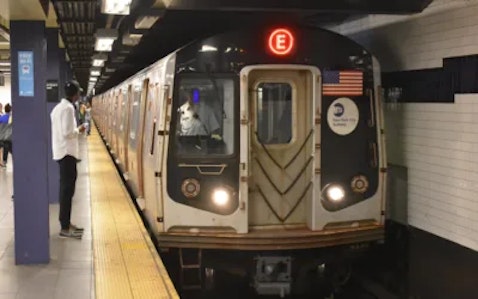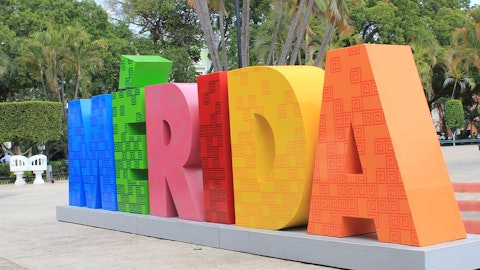In this article, we will be studying the transportation industry in the United States. We will also be looking at some of the major players in this market and the 15 best US cities for public transportation. If you wish to skip our detailed analysis, you can move directly to the 5 Best US Cities for Public Transportation.
US Public Transportation: An Overview
According to a report by the American Public Transportation Association, the US public transportation industry is a $79-billion industry. The industry comprises 1,308 rural, 945 urban, and more than 4,500 non-profit public transportation systems. The diverse modes of public transportation in the country include buses, subways, light rail, commuter trains, cable cars, ferries, monorails, tramways, and paratransit services for senior citizens and the disabled.
In terms of economic contribution, 87% of the public transportation trips in the country directly benefit the local economy. A breakdown of these trips includes 50% of them being to and from workplaces while 37% of trips lead to shopping or recreational destinations. The public transportation industry also employs more than 430,00 people. For every $1 billion invested in job creation in the industry, $382 million is generated in tax revenue.
What’s Happening in the Industry?
On January 4, Forbes reported trends from the transportation industry that could impact the future of transportation. The report highlighted the emerging trends in the US transportation sector. It implies that although the penetration of electric vehicles is low in the United States, they are still being considered as a potential alternative to combustion engines. E-bikes and autonomous vehicles, a cleaner mode of commuting, have also become popular in the US.
To build sustainable, reliable, and easy-to-access modes of transport, the state has also been keen to invest in the public transport infrastructure. On August 7, the United States Department of Transportation reported that the government has allocated $13.4 million in an attempt to create communities that have easy access to transit hubs. This measure could also reduce the carbon footprint and the costs associated with transportation for many families in the US by granting them access to transport facilities. The funding share will also aim to improve the quality of life for American citizens by giving a higher share to those with low average incomes.
Alternatives to Public Transport
Private transportation companies tend to impact the transport industry as they provide an alternative to those who are less likely to prefer public transport or simply do not have access to it. Some of the most popular alternatives to public transport services include Uber Technologies, Inc. (NYSE:UBER), Lyft, Inc. (NASDAQ:LYFT), and Alphabet Inc.’s (NASDAQ:GOOG) Waymo LLC.
Headquartered in San Francisco, Uber Technologies, Inc. (NYSE:UBER) is one of the largest ridesharing companies in the United States. The company operates through a demand-based model which implies that customers requesting rides pay the respective fares as per the traffic and driver availability. The company has been engaging with public transit firms as well. On September 7, the company reported that it supports the Dallas Area Rapid Transit (DART) to provide the largest micro-transit service in North America, through on-demand rides in 30 zones throughout and beyond DART’s 700-square-mile service area. The GoPass app required for booking a ride enhances customer satisfaction by allowing them to choose an Uber ride which offers a lower wait time of 8 minutes.
Lyft, Inc. (NASDAQ:LYFT) is another common ridesharing company in the United States. The company has been in a rigorous competition with Uber Technologies, Inc. (NYSE:UBER). On August 9, Reuters reported that the company has resorted to cutting costs and reducing its ride fares in an attempt to slow down the rapid growth of Uber Technologies, Inc. (NYSE:UBER). This move led to a rise in the number of active riders but resulted in a decline in the revenue per active rider and average per-mile fare for the company. The company is also trying to reduce surge pricing for the coming period as the high prices charged from riders during a period of high demand and fewer drivers are most often not liked by them.
Alphabet Inc.’s (NASDAQ:GOOG) Waymo LLC is an autonomous driving technology company. It offers a robo-taxi service without safety drivers in the vehicle. Being an innovative transportation provider, the company is striving to commercialize its self-driving technology through partnerships. On May 23, Reuters reported that Waymo LLC has entered into a long-term strategic partnership with Uber Technologies, Inc. (NYSE:UBER), to expand its reach in the US market. Waymo vehicles will be accessible to Uber Technologies, Inc.’s (NYSE:UBER) users who would request a ride if it’s available. This service will be operational for users within a 180-square-mile area in Phoenix, Arizona by the end of 2023. Elaborating on the scope of this partnership, Waymo’s co-CEO Tekedra Mawakana, said:
“Uber’s wide network will give Waymo, which also operates in San Francisco and is looking to expand to Los Angeles, “an opportunity to reach even more people”
Thus, Uber Technologies, Inc. (NYSE:UBER), Lyft, Inc. (NASDAQ:LYFT) and Alphabet Inc. ‘s (NASDAQ:GOOG) Waymo LLC continue to influence the local public transportation in the country. Let’s now take a look at the 15 best US cities for public transportation.
Methodology:
In order to compile a list of the 15 best US cities for public transportation, we sourced data from ALLTransit’s database which is the largest source of transit data in the country. The source uses data from 902 transit agencies, 544,823 stop locations, and 13,895 routes nationwide. It creates a ranking for US cities in terms of their public transportation through a transit performance score based on factors such as transit connectivity, access to land area and jobs, and frequency of transport service.
We further chose four key metrics from our data. We decided to give priority to our metrics to rank the cities. The primary metric we chose was the Transit Connectivity Index which represents accessibility as it is a measure of how connected the average household member is to the availability of a transit ride. Our secondary metric was the number of accessible jobs since the majority of the trips made using public transport are used to and from workplaces. The tertiary metric for this research was the Transit Access Shed, an area that can be reached within 30 minutes of a trip by public transportation. It is also a measure of connectivity as it depicts how well the public transit accesses other areas during a time frame. Finally, we considered the frequency of trips per week as our last metric since a higher frequency service depicts a well-used transit service that the public considers reliable. Thus, the relative importance of our key metrics is based upon our hypothesis of what the ‘best’ public transportation should be and our rankings are based upon these relative priorities.
Finally, we ranked the US cities in order of their transit connectivity index, number of accessible jobs, transit access shed, and frequency of trips per week, on a priority basis. For a global view on this topic, you can also take a look at the best cities for public transportation in the world.
15 Best US Cities for Public Transportation:
15. Seattle, Washington
Transit Connectivity Index: 11.7
Number of Accessible Jobs: 401,239
Transit Shed: 39
Frequency of Trips per Week: 6,152
Seattle has a lot to offer in terms of its public transportation which makes it one of the best US cities for public transit. Streetcars, metro buses, light rail, and ferries are easily accessible modes of transport for the public.
14. Minneapolis, Minnesota
Transit Connectivity Index: 12.9
Number of Accessible Jobs: 375,423
Transit Shed: 56
Frequency of Trips per Week: 4,677
An efficient and low-cost commute can be planned inside Minneapolis through its public transportation network. Metro Transit is a popular public transportation mode with commuter trains, light rail, and buses serving the city residents.
13. Portland, Oregon
Transit Connectivity Index: 13.5
Number of Accessible Jobs: 254,218
Transit Shed: 47
Frequency of Trips per Week: 8,189
Light rail, street cars, shuttles, aerial tram, and buses are affordable and convenient ways for Portlanders to reach the destination of their choice, that too at an affordable rate. The city has one of the most established public transit systems in the US.
12. Oakland, California
Transit Connectivity Index: 13.5
Number of Accessible Jobs: 388,553
Transit Shed: 43
Frequency of Trips per Week: 4,724
Bay Area Rapid Transport (BART) offers an electric train service in the city. AC Transit also provides bus services within the city. These quality services make Oakland known for its public transportation in the country.
11. Miami, Florida
Transit Connectivity Index: 14.7
Number of Accessible Jobs: 351,133
Transit Shed: 51
Frequency of Trips per Week: 3,659
The transportation has been comprehensively designed for the public in Miami. The Miami trolley service, city buses, and metro mover provide reasonable travel options, making the city one of the best US cities for public transportation.
Uber Technologies, Inc. (NYSE:UBER), Lyft, Inc. (NASDAQ:LYFT), and Alphabet Inc.’s (NASDAQ:GOOG) Waymo LLC provide suitable options for commuting to the public in the country.
10. Newark, New Jersey
Transit Connectivity Index: 14.9
Number of Accessible Jobs: 314,006
Transit Shed: 46
Frequency of Trips per Week: 5,135
Newark offers one of the best public transportation in the United States. The transportation network is extensive and allows buses, subways, and commuter trains to move people around the city.
9. Long Beach, California
Transit Connectivity Index: 17
Number of Accessible Jobs: 197,687
Transit Shed: 47
Frequency of Trips per Week: 3,162
The US cities known to be best for their public transport include Long Beach as well. Without the hassle of traffic and parking rates, people can resort to the city’s affordable light rail and buses for day-to-day commutes.
8. Baltimore, Maryland
Transit Connectivity Index: 17
Number of Accessible Jobs: 289,911
Transit Shed: 49
Frequency of Trips per Week: 3,930
Baltimore is one of the US cities with abundant public transit options. These include a subway, light rail, a downtown bus service, and water taxis.
7. Chicago, Illinois
Transit Connectivity Index: 19.1
Number of Accessible Jobs: 547,628
Transit Shed: 52
Frequency of Trips per Week: 6,190
Chicago is well known for its public transit system. This system allows the public to access their desirable locations through a combination of public transit modes such as buses, subway, water taxis, and commuter rails.
Dominant players in the overall US transportation industry include Uber Technologies, Inc. (NYSE:UBER), Lyft, Inc. (NASDAQ:LYFT), and Alphabet Inc.’s (NASDAQ:GOOG) Waymo LLC.
6. Philadelphia, Pennsylvania
Transit Connectivity Index: 20.2
Number of Accessible Jobs: 378,628
Transit Shed: 52
Frequency of Trips per Week: 5,879
Philadelphia also makes it to our list of the 15 best US cities for public transportation. Regional rail, buses, subway, and the popular trolley system are easy and convenient ways to move around the city.
Click to continue reading and see 5 Best US Cities for Public Transportation.
Suggested articles:
- 30 Low Cost Business Ideas With High Profit
- 16 Best Places to Retire in India
- 12 Best Streaming and TV Stocks To Buy Now
Disclosure: None. 15 Best US Cities for Public Transportation is originally published on Insider Monkey.






